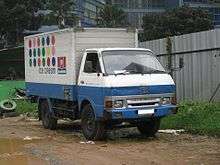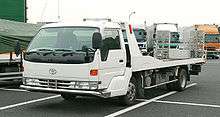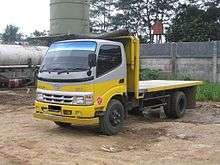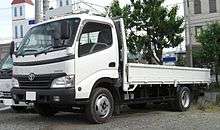Toyota Dyna
| Toyota Dyna | |
|---|---|
|
| |
| Overview | |
| Manufacturer |
Toyota Hino Kuozui Motors |
| Also called |
Daihatsu Delta Hino 300 Series Toyota Toyoace |
| Production | 1959-present |
| Assembly |
Zhongli, Taiwan[1] Ovar, Portugal[2] |
| Body and chassis | |
| Class | Truck |
| Body style | Truck (standard cab, crew cab) |
| Related | Toyota Coaster bus |
| Powertrain | |
| Transmission |
Aisin Seiki (manual) Aisin Seiki & Aisin AW (automatic) |
The Toyota Dyna is a medium-duty cab over truck for commercial use. In the Japanese market, the Dyna is sold alongside its twin called the Toyoace. The Toyoace was a renaming of the Toyopet SKB Truck as a result of a 1956 public competition with 200,000 entries.[3] "Dyna" is short for dynamic.[4]
The Dyna was originally available in Japan only at Toyota Diesel Store locations, then later available at Toyota Store locations, while the Toyoace twin was available at Toyopet Store locations. The Dyna was also sold as the Japanese: Daihatsu Delta and the Hino Dutro.
In Japan, its traditional competitors are the Isuzu Elf, the Mitsubishi Fuso Canter and the Nissan Atlas.
The former Central Motors produced the Dyna Route Van from April 1957 to June 1967.[5]
Prehistory (1956–1959)

RK52
The Toyopet Route Truck RK52 was the contributing platform of the Dyna. A new Toyota Japanese dealership was established to sell the Toyopet Toyoace series SKB called Toyopet Store, which also introduced a sedan version of this platform called the Toyopet Master.
RK60 – RK80
Second generation of Toyopet Route Truck, Designed by Kanto Auto Works, Ltd. The frame was shared with the Toyopet Masterline RK23 pickup truck and the Toyota Stout.
Early Dyna K70 – K160 (1959–1963)
The Toyopet Route Truck was renamed as the Toyota Dyna in April 1959.
K170 (1963–1968)
The original semi-cab over Dyna was replaced by the new model K170 series in September 1963, with a leaner design with quadruple headlights. The Dyna RK170 also provided the basis for the RK170B Toyota Light Bus, and was built on the chassis of the Stout. It also had the Stout's 1.9-litre 80 PS (59 kW) 3R-B engine. The Isuzu Elf was introduced in a diesel version in 1960, a version which proved successful enough to relegate the Dyna to second place in sales. Even the new Dyna didn't restore the Dyna's lead, until in March 1964 the J-engined (2,336 cc, OHV) diesel-engined JK170 was added to the lineup. A long wheelbase 2.5 ton version with twinned rear wheels was also available (RK175), as was a route van (glazed minivan) version.[6]
U10 (1968–1977)
_2000_cab_chassis_(2009-08-29).jpg)
U10/RU1#/BU1#/JU10/HU15 and more
The Dyna platform was changed to the Toyota "U" platform after the merger of Hino Motors in 1966. The engines available for this series is either a 2.0-liter model 5R gasoline engine with 93 PS (68 kW),[7] a 3.0-liter inline-four B, or the inline-six 3.6-liter model H diesel. The H diesel produces 95 PS (70 kW) and was only available in the heavier duty three-tonne truck version, which has a top speed of 100 km/h (62 mph).[7] The B diesel offers 85 PS (63 kW).[8] The three-tonne Dyna was presented in August 1969.[9] Short (10-series) and long wheelbase trucks (15-series), as well as route vans (minibus) were available. Fitted with the 2-liter 5R engine of 95 bhp, the Dyna was marketed in many export markets such as Australia as well, with single or twinned rear wheels.[10]
The Toyota Coaster bus line had the same chassis and also used the U10-series chassis codes.[11] There was also one generation of the heavier Toyota Massy Dyna, which was first introduced in September 1969.
Daihatsu Delta
A rebodied version of this Dyna was also sold as the first-generation Daihatsu Delta 1500 or 2000, depending on the weight ratio. Chassis codes are SV17 for the 12R-engined Delta 1500, DV23 for the 5R petrol model (2000) and DV28 for the B-engined Delta 2000 diesel.[12] The Delta 2000 was also available with a 2.5-litre Daihatsu DG diesel engine; this carries the DV26 chassis code.[13] At least in Australia, there was also an 85 PS (63 kW) 1861 cc petrol inline-four available.[14]
U20 / Y20 Series


2 – 3 tonner
U20, U30, U40 & U50 Series (1977–1984)
The U20 is a 4-wheel Truck & Route Van, the U30 is a standard Cab Truck with twin rear wheels, while the heavier yet U40 and U50 have twin wheels and a wider cab.
1 – 1.5 tonner
Y20 – 40 Series (1979–1985)
The new smaller Toyoace with Y20 chassis was launched in 1979, while the Dyna was still using the U-platform. This was the fourth-generation Toyoace in Japan. In certain export markets, the Toyoace was sold as Dyna, and offered as single and double cabin trucks.
Dyna Rino Y30 & Y40 Series (1984–2002)
In 1984, Toyota introduced the Dyna Rino in Indonesia. The light single rear wheel version was built on Y30 platform, and the twin rear wheel version was coded Y40. Early models have round headlights and 3.4-liter 3B and 13B engines. The facelift models with rectangular headlights, BU are powered by 3.7-liter 14B engines. The Indonesian market Dyna Rino remained in production until 2002.
Daihatsu Delta
This model was also sold as the Daihatsu Delta, in a range of 1.5 to 2.5 tonne payloads. The engines are Daihatsu's own 2-liter petrol and 2.5-liter diesel units.[15]
U60 / Y50 Series

also available as a 4-door cab with ute tray in Australia
2 – 3.5 tonner
U60 – 90 Series (1984–1994) The first bu series (Dyna 200/300/400, 1984–88) used quad round headlights. 1989 onwards models had quad rectangular headlights and one piece door glass with new interior door trim & other minor interior changes. All wide cab models had a centrally mounted roof vent and had 3 windscreen wipers. 3.4-litre 3B, 3.4-litre (direct injected) 13B and 3.7-litre 14B diesel engines with direct injection were used in the Dyna 200 and Dyna 300, a 5-speed gearbox was standard. The Dyna 300 was equipped with an exhaust brake. Front, ventilated twin piston disc brakes were optional on the first series wide cab Dyna 300.
1 – 1.5 tonner
Y50 & 60 Series (1985–1995)
U100 / Y100 Series (1995–2002)

Lowrider Cab
2 – 3.5 tonner
FB4 / 5 Series
KC-FB4J、5B
U100 – 200 Series
BU1##、BU2##
1 – 1.5 tonner
Y100 Series
YY1##
LY1## etc.
U300 – U400 Series (2000–present) and Hino Dutro


2 – 3 tonner
U300 – U500 Series
1 – 1.5 tonner
Y200 Series
New for this generation is the Hino Dutro, as Toyota owns shares in Hino. In addition to the diesel engine, the Hybrid is also sold in Japan.
The Dyna and its twin Toyoace and Dutro were built on the U300 platform for Standard Cab, or U400 platform for the Wide Cab.
Even though they were built on the U300 and U400 platforms, for marketing purpose they still used Dyna 100, 150, 200, 250, 300, and 350 which indicate the payload. The Dyna 100 is currently available with a 2.5-litre D-4D common rail turbo diesel engine offering 88bhp. The Dyna 150 is a chassis/cab version of the Dyna truck, with twin rear wheels, and an uprated 102 bhp (76 kW; 103 PS) engine, shared with the Hilux and Hiace.
The Dyna Route Van/Dutro Van are essentially standard Toyota HiAce van bodies mated with the Dyna/Dutro truck chassis.
These vehicles have emission levels which meet the stringent Euro IV requirements which took effect in Europe in 2005, in Singapore in October 2006 and was applied in Japan in February 2007.
U600 and U800 series
_Dry_van.jpg)
In 2011, The Dyna was released as the U600 and U800 series based on the second-generation Hino Dutro.
See also
References
- ↑ "國瑞汽車股份有限公司 KUOZUI MOTORS, LTD". Kuozui.com.tw. Retrieved 2010-12-19.
- ↑ "Grupo Salvador Caetano". Retrieved 2011-02-04.
- ↑ Toyota: A history of the First 50 Years. Toyota Motor Corporation. 1988. pp. 136–137. ISBN 0-517-61777-3.
- ↑ "Massy Dyna: Name origin". 75 years of Toyota: Vehicle Lineage. Toyota Motor Co. Retrieved 2013-01-16.
- ↑ "Affiliates (Toyota wholly-owned subsidiaries)-Toyota Motor East Japan, Inc.". Toyota Motor Corporation. 2012. Retrieved 2014-07-21.
- ↑ 品質と価格で奉仕するトヨタ [Quality and value at your service, from Toyota] (brochure) (in Japanese), Japan: Toyota, 1966, p. 7
- 1 2 Toyota Commercial Cars (Catalog), Toyota, 1969, p. 9
- ↑ 愛される車づくり。トヨタはあすにいどみます。 [Lovable car manufacture. Toyota dares to defy tomorrow.] (catalog) (in Japanese), Toyota Motor Co., 1972, p. 6
- ↑ "'69 商業車: ニューモデル" ['69 commercial vehicles: New models]. 月刊自動車 [The Motor Monthly] (in Japanese). 11 (8): 122. August 1969. 3439.
- ↑ Toyota Dyna 2-tonner (brochure), Australia: Toyota Motor Co., Ltd., 1965, p. 3
- ↑ Toyota Catalog (1972), p. 8
- ↑ 自動車ガイドブック 1976/1977 [Automobile Guide Book] (in Japanese). Japan: Japan Automobile Manufacturers Association. 23: 212. 1976-10-20. 0053-760023-3400. Missing or empty
|title=(help) - ↑ Automobile Guide Book 1976/1977, p. 268
- ↑ Brown, Robin, ed. (13 July 1971). "Daihatsu will return to car field". The Canberra Times. Canberra. p. 13. Retrieved 18 January 2015.
- ↑ Wright, Cedric, ed. (August 1978). "World Cars 1978". CAR (South Africa). Vol. 22 no. 7. Ramsay, Son & Parker (Pty) ltd. p. 20.
External links
| Wikimedia Commons has media related to Toyota Dyna. |
| Daihatsu road vehicle timeline, 1960–1989 — next » | ||||||||||||||||||||||||||||||||||||||
|---|---|---|---|---|---|---|---|---|---|---|---|---|---|---|---|---|---|---|---|---|---|---|---|---|---|---|---|---|---|---|---|---|---|---|---|---|---|---|
| Type | 1960s | 1970s | 1980s | |||||||||||||||||||||||||||||||||||
| 0 | 1 | 2 | 3 | 4 | 5 | 6 | 7 | 8 | 9 | 0 | 1 | 2 | 3 | 4 | 5 | 6 | 7 | 8 | 9 | 0 | 1 | 2 | 3 | 4 | 5 | 6 | 7 | 8 | 9 | |||||||||
| Kei car | Fellow/360 | Fellow Max/360 | Fellow Max/Max Cuore | Mira/Cuore | Mira/Cuore | |||||||||||||||||||||||||||||||||
| Leeza | ||||||||||||||||||||||||||||||||||||||
| Subcompact car | Consorte | Charade | Charade | Charade | ||||||||||||||||||||||||||||||||||
| Compact car | Compagno | Charmant | Charmant | Applause | ||||||||||||||||||||||||||||||||||
| Mini SUV | Taft/Scat/Wildcat | Taft/Scat/Wildcat | ||||||||||||||||||||||||||||||||||||
| Kei truck/van | Hijet | Hijet | Hijet | Hijet | Hijet | Hijet | ||||||||||||||||||||||||||||||||
| Commercial vehicle | New Line | New Line | Delta 750 | Delta 750 | Delta Van | Delta Van | ||||||||||||||||||||||||||||||||
| High Line | High Line | Delta Wide | Delta Wide | |||||||||||||||||||||||||||||||||||
| Vesta | Vesta | Delta 1500/2000 | Delta 1500/2000 | |||||||||||||||||||||||||||||||||||
| Three-wheeler | Midget | |||||||||||||||||||||||||||||||||||||
| « previous — Daihatsu road vehicle timeline, 1990s–present | ||||||||||||||||||||||||||||||||||||
|---|---|---|---|---|---|---|---|---|---|---|---|---|---|---|---|---|---|---|---|---|---|---|---|---|---|---|---|---|---|---|---|---|---|---|---|---|
| Type | 1990s | 2000s | 2010s | |||||||||||||||||||||||||||||||||
| 0 | 1 | 2 | 3 | 4 | 5 | 6 | 7 | 8 | 9 | 0 | 1 | 2 | 3 | 4 | 5 | 6 | 7 | 8 | 9 | 0 | 1 | 2 | 3 | 4 | 5 | 6 | ||||||||||
| Kei car | Mira/Cuore | Mira/Cuore | Mira/Cuore | Mira/Cuore | Mira/Cuore/Charade | |||||||||||||||||||||||||||||||
| Naked | Esse | Mira e:S | ||||||||||||||||||||||||||||||||||
| Leeza | Mira Gino | Mira Gino/Trevis | Mira Cocoa | |||||||||||||||||||||||||||||||||
| Opti | Opti | Tanto Exe | ||||||||||||||||||||||||||||||||||
| Move | Move | Move | Move | Move | ||||||||||||||||||||||||||||||||
| MAX | Sonica | |||||||||||||||||||||||||||||||||||
| Tanto | Tanto | |||||||||||||||||||||||||||||||||||
| Wake | ||||||||||||||||||||||||||||||||||||
| Subcompact car | Mira Gino 1000 | Ayla | ||||||||||||||||||||||||||||||||||
| Charade | Charade | Ceria | Charade | |||||||||||||||||||||||||||||||||
| Storia/Sirion | Boon/Sirion | Boon/Sirion | Boon | |||||||||||||||||||||||||||||||||
| Compact car | Applause | |||||||||||||||||||||||||||||||||||
| Mid-size car | Altis | Altis | Altis | Altis | ||||||||||||||||||||||||||||||||
| Sports car | Leeza Spider | Copen | Copen | |||||||||||||||||||||||||||||||||
| Mini MPV | YRV | Coo/Materia | ||||||||||||||||||||||||||||||||||
| Boon Luminas | ||||||||||||||||||||||||||||||||||||
| Pyzar/Gran Move | Pyzar/Gran Move | Xenia | Xenia | |||||||||||||||||||||||||||||||||
| Mini SUV | Rocky/Feroza/Sportrak | Rocky/Feroza/Sportrak | ||||||||||||||||||||||||||||||||||
| Terios/Taruna | Be-go/Terios | |||||||||||||||||||||||||||||||||||
| Terios Kid | ||||||||||||||||||||||||||||||||||||
| Compact SUV | Rugger/Fourtrak/Taft | Rugger/Fourtrak | ||||||||||||||||||||||||||||||||||
| Kei truck/Microvan | Hijet | Hijet | Hijet | Hijet | ||||||||||||||||||||||||||||||||
| Midget II | ||||||||||||||||||||||||||||||||||||
| MUV/Light commercial vehicle | Delta Van | Delta Van | Zebra | |||||||||||||||||||||||||||||||||
| Delta | Delta | Delta | ||||||||||||||||||||||||||||||||||
| Atrai 7 | ||||||||||||||||||||||||||||||||||||
| Hijet Gran Cargo/Extol | Gran Max | |||||||||||||||||||||||||||||||||||
| Luxio | ||||||||||||||||||||||||||||||||||||